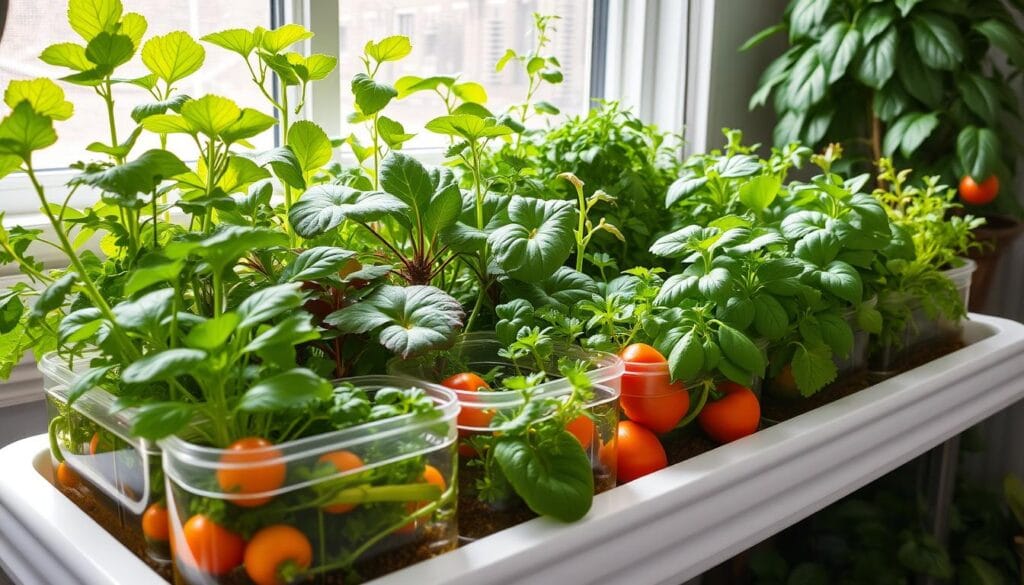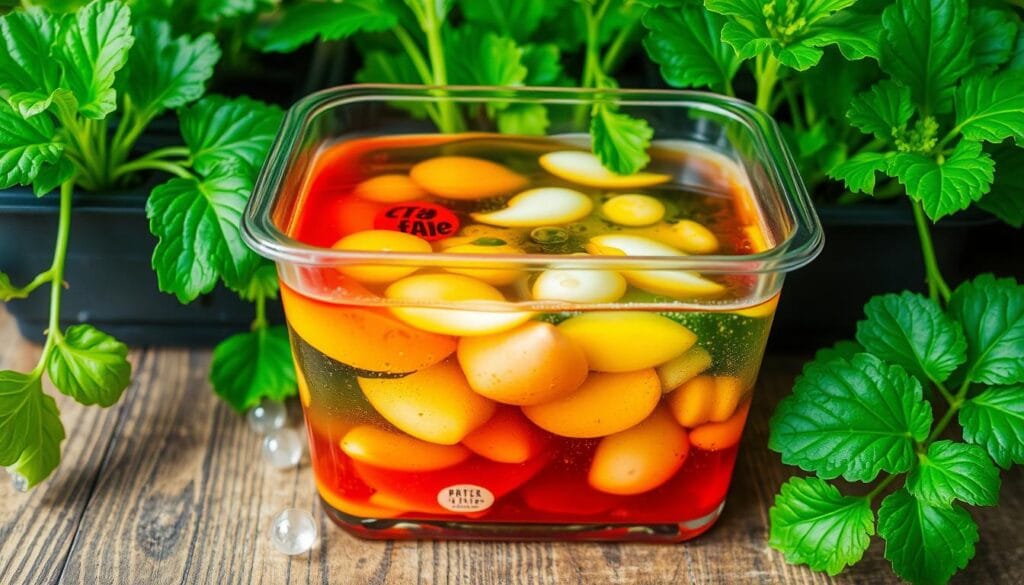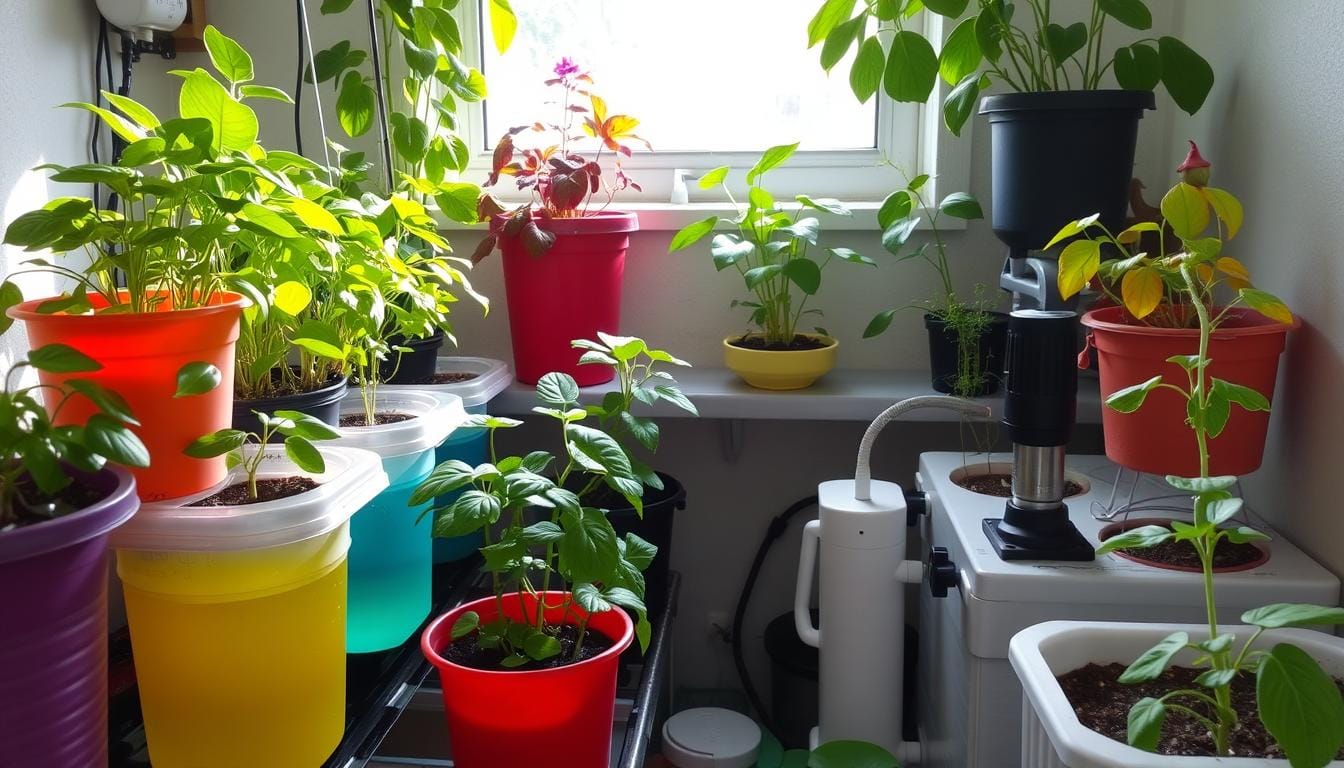Explore the world of diy hydroponics on a budget and learn to grow your own plants affordably. Hydroponics is a method that doesn’t use soil. It offers big harvests, quick growth, and fewer pests. This way of gardening is good for the planet and lets you grow many vegetables and herbs.
You can start with a budget-friendly hydroponics kit or make your own homemade hydroponics systems. This way, you can have an indoor garden all year. The weather outside won’t affect your garden.
Key Takeaways
- Hydroponics is a soil-free gardening method that allows for faster growth and higher yields.
- DIY hydroponics systems can be created on a budget using affordable materials and repurposed items.
- Hydroponic gardening offers the flexibility to grow a variety of plants, including vegetables and herbs, indoors year-round.
- Choosing the right hydroponic system, such as a wick, flood and drain, or water culture system, can cater to different plant needs.
- Careful management of factors like lighting, nutrient solutions, and water quality is essential for a successful hydroponic setup.
Understanding Basic Hydroponic Growing Methods
If you’re looking to start a hydroponic setup on a budget, knowing the basics is key. There are many affordable hydroponics solutions out there. Let’s explore the main types to find the right fit for you.
Wick Systems for Beginners
The wick system is great for beginners. It uses a wick to pull water from a reservoir up to the plants. This method is easy to maintain and works well for herbs and leafy greens.
Flood and Drain Systems
Flood and drain systems, or ebb and flow, use a pump to flood the trays with solution. The solution then drains back, giving plants the water and nutrients they need. It’s a good choice for many plants in a low-cost hydroponic setup.
Water Culture Systems
In water culture systems, roots stay in a nutrient-rich solution all the time. An air pump and diffuser add oxygen. It’s perfect for leafy greens and fast-growing plants that love moist conditions.
Each hydroponic growing method has its own benefits. They’re suited for different plants and spaces. Knowing the differences helps you choose the best diy hydroponic setup for your needs and budget.
“Hydroponics can extend the growing season by starting seeds earlier or by extending plants later, allowing flexibility beyond seasonal changes.”
Essential Components for Budget Hydroponic Setup
Starting a hydroponic garden on a budget is possible. You can create a lush indoor space without spending a lot. The trick is to know the must-have items for your inexpensive hydroponic methods.
The core of any budget hydroponic supplies setup is the growing container. This is usually a 20-30 gallon reservoir, costing $20-$40. It’s where the nutrient-rich water lives, giving your plants a stable home to grow.
- Grow tray: $15-$30 for a sturdy, food-grade container to hold your plants.
- Water pump: $20-$40 for a reliable pump to circulate the nutrient solution.
- Air pump and stones: $40-$55 to ensure adequate oxygenation for your plants’ roots.
- Net pots: $5-$10 for 6-8 pots to hold your plants and growing medium.
- Growing medium: $10-$20 for Rockwool, Hydroton, or coco coir to support your plants’ roots.
- Nutrients: $20-$30 for a balanced nutrient solution to provide essential elements for healthy growth.
- pH meters and adjusters: $20-$40 to maintain the ideal pH level for optimal nutrient uptake.
Though starting a cost-effective hydroponic growing setup might seem expensive at first, it’s worth it. You’ll save money by growing your own food. By choosing the right parts and following good practices, you can have a budget hydroponic supplies system. It will give you plenty of fresh, healthy food without costing too much.
DIY Hydroponics on a Budget: Getting Started
Starting a hydroponic garden doesn’t have to cost a lot. You can make your own budget-friendly hydroponics system with some creativity. Look for cheap materials and use simple designs to grow your favorite plants at home.
Sourcing Affordable Materials
First, look for cheap materials at thrift stores, yard sales, and online. Use items like plastic containers, PVC pipes, and old aquariums. You can also ask your community for used hydroponics gear.
Building Your First System
For homemade hydroponics systems, keep it simple. Choose designs like the Deep Water Culture (DWC) or Kratky method. They need little equipment and care. These systems let you grow many plants, like greens and small fruits, without spending a lot.
Cost-Saving Tips and Tricks
- Make your own nutrient solutions to save money on commercial mixes.
- Grow plants close together and reuse water to save resources.
- Use manual watering for small systems to avoid expensive air pumps.
With creativity and a bit of effort, you can have a diy hydroponics on a budget. Enjoy growing your own food without spending a lot.
Selecting the Right Plants for Your System
Choosing the right plants is key to budget-friendly hydroponic gardening. Beginners should pick crops with shallow roots and quick growth. Leafy greens like lettuce, kale, and spinach grow well and give a quick harvest.
Herbs such as basil, cilantro, and oregano are also good choices. They need fewer nutrients and are easy to care for.
Think about your hydroponic system’s needs when picking plants. NFT systems are perfect for fast-growing greens. DWC setups are great for plants like kale and cucumbers that need good air.
Flood and drain systems are best for plants needing lots of light and air. This includes strawberries, tomatoes, and basil.
For a budget-friendly garden, choose hardy plants. Green onions are a good choice, ready in 3-4 weeks. Microgreens like broccoli and radish are also great, ready in 1-3 weeks.
Consider the upkeep needed and choose plants that match your budget and skills. With careful planning, you can grow a lot while saving money.
| Hydroponic System | Recommended Plants |
|---|---|
| Nutrient Film Technique (NFT) | Leafy greens, herbs, microgreens |
| Deep Water Culture (DWC) | Kale, bok choy, cucumbers |
| Flood and Drain (Ebb and Flow) | Strawberries, tomatoes, basil |

“Hydroponic farming is gaining popularity due to the need to find innovative ways to feed a growing population amidst worsening climate change impacts.”
Lighting Solutions for Indoor Hydroponics
Getting the right lighting is key for affordable hydroponics solutions. Whether you’re into diy hydroponic techniques or setting up a low-cost hydroponic setup, knowing your lighting options is vital. It’s all about success in your garden.
Fluorescent vs. LED Options
Fluorescent tubes are a great start for beginners. They offer a full-spectrum 6500K range, perfect for big gardens. For smaller spaces, compact fluorescent (CFL) bulbs are a smart choice. Use reflectors to spread the light evenly.
LED grow lights are becoming more popular for their energy use. They might cost more at first, but save money on electricity in the long run. Plus, they don’t get hot, which is good for your plants.
Natural Light Integration
Using natural light can cut down on artificial lighting costs. Place your setup near windows or skylights to catch the sun. Remember to adjust your lighting schedule with the seasons.
Light Scheduling Tips
- Aim for a consistent 15-20 hour daily light cycle for most hydroponic plants.
- Use programmable timers to ensure your lights turn on and off at the same time every day.
- Experiment with different light schedules to find the optimal balance between plant growth and energy efficiency.
By exploring your lighting options and optimizing your setup, you can grow a thriving indoor garden affordably. Dive into the world of affordable hydroponics solutions and watch your plants thrive with the right diy hydroponic techniques and low-cost hydroponic setup.
Nutrient Management and Water Quality
Keeping your inexpensive hydroponic methods and cost-effective hydroponic growing systems in top shape is key. To get the most out of your budget hydroponic supplies, follow these important tips:
- Use filtered water instead of tap water to avoid harmful elements that can compromise plant health.
- Maintain water temperature between 65-75°F and pH levels between 5.7-6.3 for optimal nutrient uptake.
- Add hydroponic nutrients following the instructions provided by the brand, ensuring the right balance of essential macro and micronutrients.
- Keep the water moving with bubblers or pumps to prevent stagnation and promote oxygenation for healthy root development.
- Empty, clean, and refill the nutrient reservoir every two weeks to maintain water quality and prevent the buildup of contaminants.
- After each harvest, thoroughly clean the entire system to prepare for the next growing cycle.
By closely monitoring and managing the nutrient solution and water quality, you can ensure your inexpensive hydroponic methods, cost-effective hydroponic growing, and budget hydroponic supplies work together to support the optimal growth and development of your plants.
| Product | Price | Features |
|---|---|---|
| Rise Gardens | $349.00 | 1-year warranty |
| Lettuce Grow | $699.00 | 90-day return policy, made using ocean-bound plastic |
| Gardyn | $899.00 | Patented Hybriponics™ Technology, saves 95% more water |
| Click & Grow | $99.95 | Biodegradable plant pods, over 75 varieties |
| Aerogarden | $59.95 | Accommodates 3 to 30 plants, some models are wifi-enabled |

“In hydroponic systems, most plant nutrients are supplied through nutrient solutions rather than soil.”
Creating Your Own Nutrient Solutions
Growing plants with a budget-friendly hydroponics setup doesn’t mean you have to sacrifice nutrient quality. Making your own nutrient solutions can be both affordable and effective. It ensures your plants get the essential elements they need to thrive. Let’s look at how to make homemade nutrient formulations, balance pH, and control water temperature for your diy hydroponics on a budget.
Basic Nutrient Formulations
For an optimal nutrient solution on a budget, focus on the right balance of nutrients. Use ingredients like compost tea or worm castings for a nutrient-rich base. This approach can save you money on pre-made fertilizers while still nourishing your plants.
pH Balancing Methods
Keeping the right pH level in your affordable hydroponics solutions is key for nutrient uptake and plant health. Use pH Up and pH Down adjusters to keep the pH between 5.5 and 6.5. Regular checks and small adjustments will help you find the perfect balance for your homemade hydroponics systems.
Water Temperature Control
Temperature is crucial for nutrient solution effectiveness. Aim for water temperatures between 65-75°F for best plant growth. In extreme weather, use an aquarium heater or cooler to keep the water at the ideal temperature. This ensures your plants get the nutrients they need.
By making your own nutrient solutions, balancing pH, and controlling water temperature, you can create a thriving affordable hydroponics setup at home. With some experimentation and attention to detail, you’ll be growing a bountiful harvest of fresh produce.
System Maintenance and Troubleshooting
Keeping your hydroponic system in good shape is key for healthy plants and avoiding big problems. Check the pH levels and nutrient amounts often. This keeps your plants happy and growing well.
Clean and sanitize all parts of your system, like grow trays and tubing. This stops algae and diseases from spreading. It’s important for your plants’ health.
Watch your plants for signs of trouble, like wilting or slow growth. Fixing these issues quickly helps your plants grow better. Keeping records of your system’s performance helps you grow even more in the future.
Regular upkeep and quick problem-solving are essential for a thriving hydroponic setup. With some practice and care, your plants will flourish. And your investment in this hobby will be worth it.

